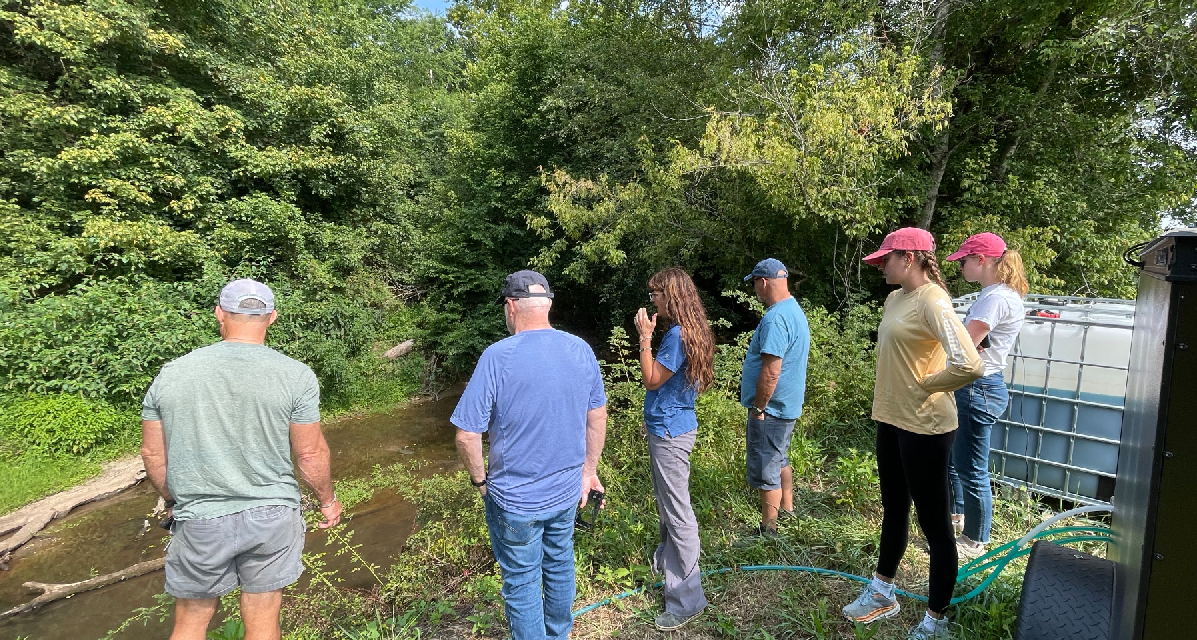As of mid-July, the Lake Anna Cyanobacteria Mitigation and Remediation program (LACMRP) is well underway in both the upper North Anna River and in the Terry’s Run tributaries of the lake. All the treatment tasks are complete and those involved are now in the monitoring and data analysis stage of the plan. Here are some facts on what has been completed to date.
In the Upper North Anna River, EutroPHIX and their partner SOLitude Lake Management, completed treatments to inactivate approximately 8% of excess phosphorus loads in the lake sediment on June 20. Several boats were used to apply the lanthanum-based product which “mineralizes” soluble phosphorus in the lake sediment.
EutroPHIX utilized EutroSORB G to bind excess soluble phosphorus in the lake sediment. The product was deployed as a slurry by certified and licensed applicators. They deployed 88,000 pounds of EutroSORB G to the in-scope area of the upper North Anna River. As expected, there was a noticeable color change in the water for about 1-2 hours after the application.

The EutroPHIX technical approach also includes an injection and monitoring system that is installed approximately 1.6 miles upstream of the lake to address phosphorus flows from the watershed.
The injection system includes the pumps and hardware to inject their EutroSORB WC product into the flowing water and two water quality monitoring systems that continuously monitor the water flowing in the river for nutrients to include the amount of phosphorus in the water.
The injection system is installed on the Dominion Energy easement of a farm in Orange County. It is fully installed and EutroPHIX engineers are calibrating and “dialing in” the system to achieve maximum effectiveness. EutroPHIX collected water quality samples at three monitoring sites prior to, during, and after the EutroSORB G treatment and the initiation of the injection system.
In Terry’s Run, Clean Streams Rivers and Lakes (CSRL) completed treatments to inactivate excess phosphorus in the lake sediment on June 26. The Terry’s Run treatment area includes the entire length of Terry’s Run, from the headwaters to the confluence with Pamunkey Creek. CSRL deployed 9,000 pounds of Wollastonite, a granular calcium silicate product across the treatment area over a 10-day period.
Calcium silicate is a phosphorus binding agent that creates a permanent bond with dissolved phosphorus in the lake sediment. The calcium silicate was deployed from boats by a licensed and certified applicator and as expected, there also was a noticeable color change in the water for about 1-2 hours after the application.
CSRL’s technical approach also employs bioreactors that contain beneficial bacteria that are voracious consumers of both dissolved phosphorus and dissolved nitrogen. CSRL deployed more than 830 of these bio-reactors throughout the Terry’s Run area.
The bioreactors work collaboratively with the calcium silicate treatments to reduce excess phosphorus levels in that part of the upper reservoir.
The bio-reactors range in size from a small ceramic “rock” to large, custom made enclosures that were hung from several of the existing buoys already in the water.
CSRL completed the installation of the bio-reactors on July 15. The owners of the buoys being used to host the bio-reactors provided their approval to install the pods under the buoys.

CSRL collected water quality samples at two monitoring sites prior to and after the calcium silicate treatments. They are working with a professor from George Mason University to do cyanobacteria cell counts and the Lake Anna Civic Association (LACA) for water quality collection of several water quality parameters.
The remaining tasks for this year include monthly monitoring of sampling stations on both the Upper North Anna River and in Terry’s Run and the analysis of data collected during these monitoring sessions to determine the effectiveness of the treatments. Monitoring will be conducted monthly by both EutroPHIX and CSRL and the data analysis will be conducted by the Lake Anna Advisory Committee (LAAC).
“One thing to keep in mind, our efforts to reduce excess phosphorus in the upper reservoir is a marathon event, not a sprint. It will take repeated treatments over several years to see the full results that we are working to achieve. HAB advisories will most likely be a continued nuisance, at least for this year and next year as we work to reduce phosphorus levels that feed the cyanobacteria as water temperatures increase. We must be patient and let the program do its work. These approaches have worked in many other areas of the country with significant water quality improvements and no harmful or unintended consequences to the environment. We are out of the starting gate but we have a lot of work in front of us before we cross the finish line,” noted Harry Looney Environmental & Water Quality Subcommittee Chairman and member of LAAC.
Chairman of LAAC, Louisa County Supervisor Christopher C. McCotter recently toured the EutroPHIX injection and monitoring systems on site and told Life & Times, “While we don’t know if these experiments are working yet, I believe we have the tools in place to determine which method is better suited to use in subsequent years of phosphorus mitigation. This is a good start. I look forward to seeing data in September.”
At press time Eutrophix had notified LAAC of a plan to spread excess EutroSORB WC in the upper North Anna. LAAC passed a motion supporting the idea but made it contingent on approval from DWR, Dominion, DEQ.
























